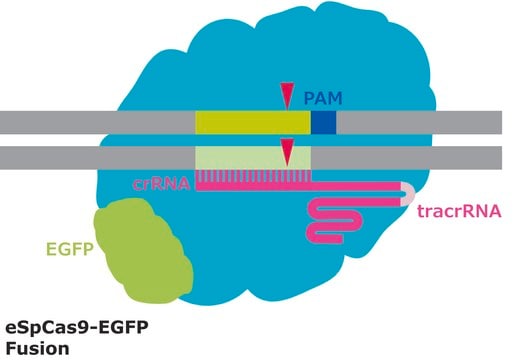ESPCAS9PRO
eSpCas9 Protein
from Streptococcus pyogenes with mutations conferring enhanced specificity, recombinant, expressed in E. coli, 1X NLS
Synonym(s):
Enhanced specificity Cas9, eCas9, eSpCas9, eSpCas9 1.1, eSpyCas9
Sign Into View Organizational & Contract Pricing
All Photos(1)
About This Item
UNSPSC Code:
12352202
NACRES:
NA.51
Recommended Products
recombinant
expressed in E. coli
Quality Level
Assay
≥95% (SDS-PAGE)
form
lyophilized powder
packaging
pkg of 1 kit (3 components)
application(s)
CRISPR
shipped in
ambient
storage temp.
−20°C
General description
Recombinant eSpCas9 protein from Streptococcus pyogenes (~160 KD) is a ready-to-use reagent for genome engineering experiments. When combined with target-specific guide RNAs, eSpCas9 protein will act as a targeted nuclease suitable for transfection of cell cultures and for the accelerated development of genetically-modified animals via one-cell embryo injection.
Application
Functional Genomics/Target Validation/Genome Editing
Features and Benefits
- Enhanced specificity compared to wild type Cas9
- Highly active
- Ready-to-inject/transfect
Packaging
pkg of 50 μg
pkg of 250 μg
pkg of 250 μg
Components
Each kit consists of:
- one vial of eSpCas9 recombinant protein
- one vial containing 1 mL of 1× dilution buffer
- one vial containing 1 mL of nuclease-free water with glycerol
Principle
Newly engineered eSpCas9 enables the efficient targeted gene editing of established CRISPR systems with the benefit of reduced off-target effects. Point mutations in the chromosome-binding motif of SpCas9, as described by Slaymaker, et al., provide higher on-target fidelity without loss of cleavage efficiency.
Reconstitution
Lyophilized S. pyogenes eSpCas9 protein should be resuspended in the Reconstitution solution provided to desired concentration for storage. Gently tap tube to completely dissolve lyophilized powder, incubate for 10 minutes on ice, and spin tube to bring material to bottom of tube.
Other Notes
Use our CRISPR Selection Tool to order gRNA
Check out our other MISSION® Cas9 Proteins at SigmaAldrich.com/CRISPRproteins
Check out our other MISSION® Cas9 Proteins at SigmaAldrich.com/CRISPRproteins
Legal Information
MISSION is a registered trademark of Merck KGaA, Darmstadt, Germany
Kit Components Only
Product No.
Description
- Enhanced specificity Cas9-NLS from Streptococcus pyogenes, expressed in Escherichia coli
- Dilution buffer for Cas9 proteins
- Reconstitution solution for Cas9 proteins
Storage Class Code
10 - Combustible liquids
Flash Point(F)
Not applicable
Flash Point(C)
Not applicable
Certificates of Analysis (COA)
Search for Certificates of Analysis (COA) by entering the products Lot/Batch Number. Lot and Batch Numbers can be found on a product’s label following the words ‘Lot’ or ‘Batch’.
Already Own This Product?
Find documentation for the products that you have recently purchased in the Document Library.
Customers Also Viewed
CRISPR off-target analysis in genetically engineered rats and mice
Keith R. Anderson, et al
Nature Methods (2018)
Evan R Stark-Dykema et al.
Scientific reports, 12(1), 8554-8554 (2022-05-21)
Mammalian sex chromosomes are enriched for large, nearly-identical, palindromic sequences harboring genes expressed predominately in testicular germ cells. Discerning if individual palindrome-associated gene families are essential for male reproduction is difficult due to challenges in disrupting all copies of a
CRISPR/Cas9 Endonuclease-Mediated Mouse Genome Editing of One-Cell and/or Two-Cell Embryos by Electroporation, and the Use of Rad51 to Enhance Knock-In Allele Homozygosity via Interhomolog Repair Mechanism.
Garza, et al.
Methods in Molecular Biology, 2631, 253-266 (2023)
Vasin Dumrongprechachan et al.
eLife, 11 (2022-10-15)
Mammalian axonal development begins in embryonic stages and continues postnatally. After birth, axonal proteomic landscape changes rapidly, coordinated by transcription, protein turnover, and post-translational modifications. Comprehensive profiling of axonal proteomes across neurodevelopment is limited, with most studies lacking cell-type and
Yuki Matsushita et al.
Nature communications, 14(1), 2383-2383 (2023-05-15)
The bone marrow contains various populations of skeletal stem cells (SSCs) in the stromal compartment, which are important regulators of bone formation. It is well-described that leptin receptor (LepR)+ perivascular stromal cells provide a major source of bone-forming osteoblasts in
Our team of scientists has experience in all areas of research including Life Science, Material Science, Chemical Synthesis, Chromatography, Analytical and many others.
Contact Technical Service












